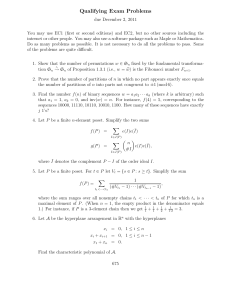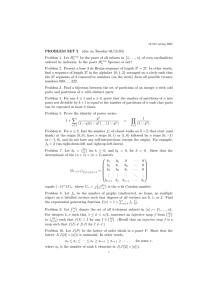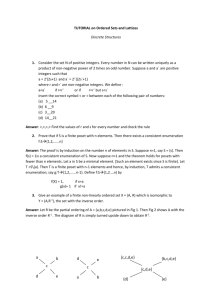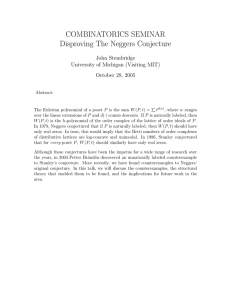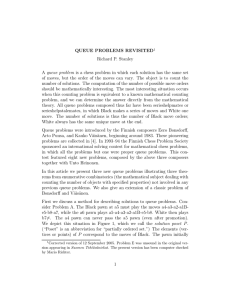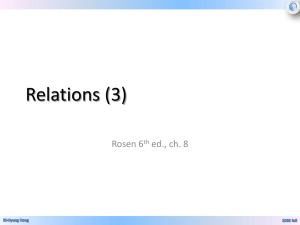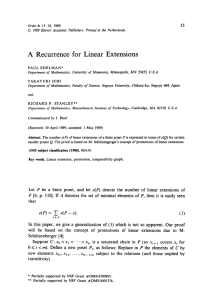MULTI-ORDERED POSETS Lisa Bishop
advertisement
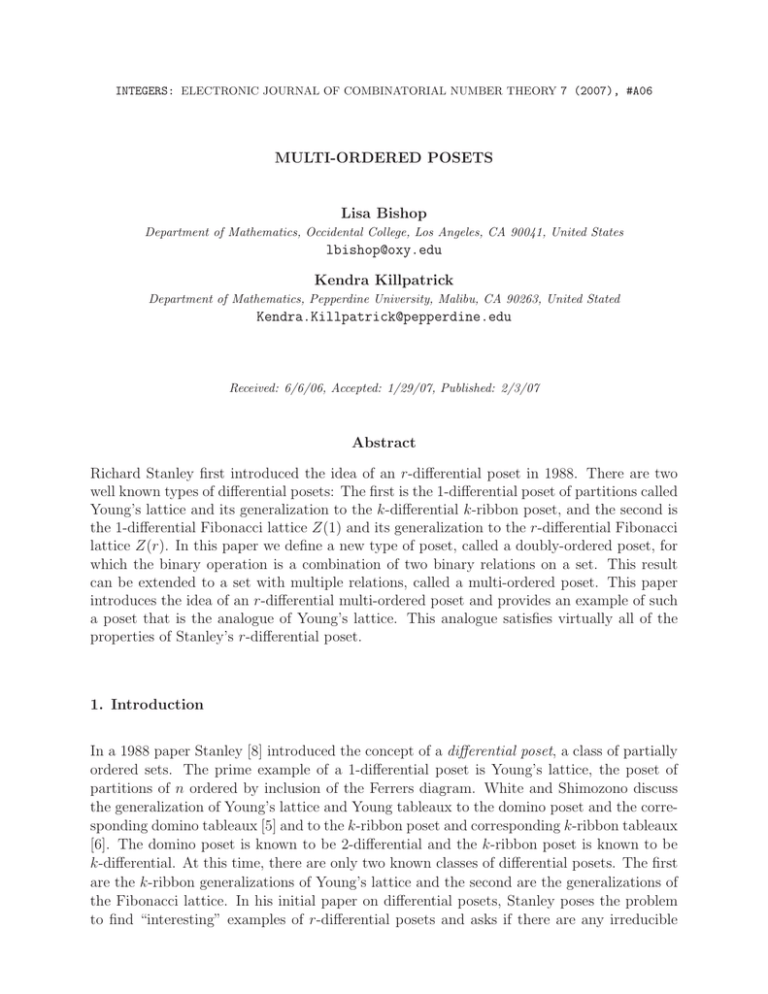
INTEGERS: ELECTRONIC JOURNAL OF COMBINATORIAL NUMBER THEORY 7 (2007), #A06
MULTI-ORDERED POSETS
Lisa Bishop
Department of Mathematics, Occidental College, Los Angeles, CA 90041, United States
lbishop@oxy.edu
Kendra Killpatrick
Department of Mathematics, Pepperdine University, Malibu, CA 90263, United Stated
Kendra.Killpatrick@pepperdine.edu
Received: 6/6/06, Accepted: 1/29/07, Published: 2/3/07
Abstract
Richard Stanley first introduced the idea of an r-differential poset in 1988. There are two
well known types of differential posets: The first is the 1-differential poset of partitions called
Young’s lattice and its generalization to the k-differential k-ribbon poset, and the second is
the 1-differential Fibonacci lattice Z(1) and its generalization to the r-differential Fibonacci
lattice Z(r). In this paper we define a new type of poset, called a doubly-ordered poset, for
which the binary operation is a combination of two binary relations on a set. This result
can be extended to a set with multiple relations, called a multi-ordered poset. This paper
introduces the idea of an r-differential multi-ordered poset and provides an example of such
a poset that is the analogue of Young’s lattice. This analogue satisfies virtually all of the
properties of Stanley’s r-differential poset.
1. Introduction
In a 1988 paper Stanley [8] introduced the concept of a differential poset, a class of partially
ordered sets. The prime example of a 1-differential poset is Young’s lattice, the poset of
partitions of n ordered by inclusion of the Ferrers diagram. White and Shimozono discuss
the generalization of Young’s lattice and Young tableaux to the domino poset and the corresponding domino tableaux [5] and to the k-ribbon poset and corresponding k-ribbon tableaux
[6]. The domino poset is known to be 2-differential and the k-ribbon poset is known to be
k-differential. At this time, there are only two known classes of differential posets. The first
are the k-ribbon generalizations of Young’s lattice and the second are the generalizations of
the Fibonacci lattice. In his initial paper on differential posets, Stanley poses the problem
to find “interesting” examples of r-differential posets and asks if there are any irreducible
INTEGERS: ELECTRONIC JOURNAL OF COMBINATORIAL NUMBER THEORY 7 (2007), #A06
2
differential lattices besides the generalizations of Young’s lattice and the Fibonacci lattice.
In this paper we define both a doubly-ordered poset and a more general multi-ordered
poset, which are “almost” differential according to Stanley’s definition and that we think are
“interesting”. We define a differential doubly-ordered poset and a differential multi-ordered
poset and prove which of Stanley’s conditions on differential posets apply to this new hybrid
poset. As with the two standard classes of differential posets, the multi-ordered poset gives
rise to many interesting questions about the number of chains in this poset and the tableau
representations of these chains. We discuss these open problems in Section 6.
2. Background and Definitions
In this section we present some necessary definitions related to tableaux and posets. For a
more complete exposition, the reader is referred to Stanley’s excellent book on Enumerative
Combinatorics [7].
Let λ = (λ1 , λ2 , . . . , λk ) be a k-tuple of non-negative integers. We say that λ is a partition
of n if λ1 + λ2 + · · · + λk = n and λ1 ≥ λ2 ≥ · · · ≥ λk > 0.
A Ferrers diagram describes a partition λ pictorially through an array of n dots in k
left-justified rows with row i containing λi dots for 1 ≤ i ≤ k. For example, the Ferrers
diagram for the partition λ = (7, 5, 3, 3, 1) is:
•
•
T = •
•
•
•
•
•
•
• • • • •
• • •
•
•
If λ is a partition and µ is a partition whose Ferrers diagram is contained in the Ferrers
diagram of λ, then the skew shape λ/µ is the set of cells obtained by deleting the cells of µ from
λ. For example, for λ = (5, 3, 3, 1) and µ = (4, 2, 1) then the skew shape (5, 3, 3, 1)/(4, 2, 1)
looks like the following, where µ is shown by X’s:
X X X X •
X X •
λ/µ =
X • •
•
A diagonal for a tableau is any line with slope of −1 through the Ferrers diagram of that
tableau.
Definition 1. A partially ordered set, or poset, is a set A together with a binary relation,
≤, such that for every a, b, c ∈ A:
INTEGERS: ELECTRONIC JOURNAL OF COMBINATORIAL NUMBER THEORY 7 (2007), #A06
3
1. a ≤ a,
2. a ≤ b and b ≤ a implies a = b, and
3. a ≤ b and b ≤ c implies a ≤ c
An element a in a poset P covers an element b ∈ P if b ≤ a and there is no c such that
b < c < a. We will write b ! a to indicate that a covers b.
We say that the poset P has a 0̂ if there exists an element 0̂ ∈ P such that 0̂ ≤ x for all
x ∈ P . If every interval of P is finite, then the poset P is said to be locally finite. A chain
is a poset in which any two elements are comparable. The chain C in poset P is saturated
if there does not exist a z ∈ P − C such that x < z < y for some x, y ∈ C. In a locally finite
poset, the chain x0 < x1 < ... < xn is saturated if and only if xi covers xi−1 for 1 ≤ i ≤ n.
We say that the chain x0 < x1 < ... < xn is a chain of length n. A poset P is called graded
if it has a minimum element 0̂ and if for each a ∈ A all maximal chains from 0̂ to a have
the same length. We say a, b ∈ P have a greatest lower bound, or meet, if there is a c ∈ P
such that c ≤ a, c ≤ b and for any d such that d ≤ a, d ≤ b, then d ≤ c. The least upper
bound, or join, of a and b is defined similarly by reversing the inequalities. A poset where
every pair of elements have a meet and a join is called a lattice.
In 1988 R. Stanley [8] gave the following definition of an r-differential poset.
Definition 2. An r-differential poset, P, is a poset which satisfies the following three conditions:
1. P has a 0̂, is graded and is locally finite.
2. If x %= y for x, y ∈ P and there are exactly k elements in P which are covered by both
x and y, then there are exactly k elements in P which cover both x and y.
3. For x ∈ P , if x covers exactly k elements of P , then x is covered by exactly k + r
elements of P .
The classic example of a 1-differential poset is Young’s lattice, the poset of the set of
partitions together with the binary relation λ ≤ µ if and only if λi ≤ µi for all i.
The first seven rows of Young’s lattice are shown below, with lines drawn to indicate
cover relations.
INTEGERS: ELECTRONIC JOURNAL OF COMBINATORIAL NUMBER THEORY 7 (2007), #A06
&&
&
••••• •••••
•
•
•••••• •••••• ••••••
••••••
%
%
%
&
%
•••••
•••••
&&
' ) &
(
( )') &##
( '
#&
)
) (' #
&
%
&
& -
-
--
,
,
••••
% +
%+
+ %
+
%
•
•••
,
.
,
.
, .
&
&
&
" **
"
*"
"
*
••
••
"
"
"
"
•••
!
!
!
••
••
••
$ ##
% !! "$"
%
!%
$ #""
!
% $#
••••
•
•••••
,
•••
••
•
+
+
+
+
••
•
& !
!
!
••
•
!
!!
' !
!!
••
••
••
!
!!
••
••
••
4
••
••
•
••
••
••
••
%
%
%
&
&
#
# '
# '
••
••
'
#
#
#
••
••
•
••
••
•
''
••
••
••
•
*
*
*
∅
3. Domino Tableaux
A domino is a pair of adjacent dots in a Ferrers diagram. If the dots lie in the same row, we
will call them a horizontal domino and if they lie in the same column, we will call them a
vertical domino.
A domino shape is a Ferrers diagram that can be completely divided into dominos, which
we will call a tiling of the shape. For example, the partition λ = (4, 3, 3, 1, 1) can be
represented by the following Ferrers diagram:
• • • •
• • •
• • •
•
•
This partition is a domino shape since it can be tiled by dominos as follows:
INTEGERS: ELECTRONIC JOURNAL OF COMBINATORIAL NUMBER THEORY 7 (2007), #A06
5
• • • •
• • •
• • •
•
•
Note that no partitions of odd numbers are domino shapes although not all partitions of
even numbers are domino shapes. In addition, the tiling of a domino shape is not necessarily
unique. The λ from our previous example can also be tiled as follows:
• • • •
• • •
• • •
•
•
To create a domino tableau, first tile a domino shape with dominos. Then fill the dominos
with the numbers 1, 2, . . . , n such that the numbers in each domino are identical, each number
appears in exactly one domino, and rows and columns weakly increase. For example:
1 1 2 2
3 4 6
3 4 6
5
5
Again, there may be more than one domino tableau for a given domino shape and tiling.
The domino poset, D, is the set of domino shapes together with the following binary
relation. For two domino shapes λ and µ with µ ⊆ λ, we say that λ covers µ, µ ! λ, if
λ/µ is a domino. In general, for µ ⊆ λ, µ ≤ λ in the domino poset if λ/µ can be tiled by
dominos, i.e., we can obtain µ by successively removing dominos from λ, or we can obtain λ
by successively adding dominos to µ.
The first four rows of the domino poset are shown below:
INTEGERS: ELECTRONIC JOURNAL OF COMBINATORIAL NUMBER THEORY 7 (2007), #A06
••
•••••• ••••
'
'
••
•• •••• ••••
•• ••
••
••
••
•• •••••
•
•••
•••
•••
••
•
6
••
••
••
8
8
$ 21 55 3
9 2
4 66
21 '
5
''
7
$ 12
9
288
3 54
12 '
2 ' $ 1
' 9 88 2 '
2
3 455 6 7
1
56 7
2' $1
' 98
2' 1
2 3 4
••
••
••••
0
00
00
0
••••
•••
•
/ 0
/
00
//
00
/
/
0
••
00
00
0
∅
/
//
//
••
••
••
/
/
//
/
/
If we let Y denote Young’s lattice, then the domino poset is isomorphic to Y 2 (see [5] for
a nice description) and thus is 2-differential.
We will call a 2-core a shape from which no domino can be removed. The only 2-cores
are ”stair-step” shapes in which λ = (n, n − 1, n − 2, ..., 1).
We can use the 2-cores as a base upon which to build a poset. For instance we can take
the partition λ= (2, 1) as our 2-core and define our set as the set of all partitions containing
(2, 1) which can be formed by successively adding either horizontal or vertical dominos to
(2, 1). Here are the first three rows of a domino poset built on the 2-core λ=(2, 1):
XX••••
X
"
"
"
XX••
X ••
"
+
XX••
X
+
+
+
00
00
0
XX••
X
••
"
XX
X•
•• •
/
//
//
XX
X
••
"
"
XX
X
•
+ •
••
+
+
XX
X
A domino poset constructed on a 2-core is easily shown to be isomorphic to the standard
domino poset and thus is also 2-differential. The domino poset can be generalized to the
k-ribbon poset. A k-ribbon is defined as k adjacent dots in the Ferrers diagram none of
which lie on the same diagonal. For the binary relation ≤ in the k-ribbon poset, we say
µ ≤ λ if µ ⊆ λ and λ can be formed by adding some number of k-ribbons to µ. Note that a
2-ribbon is simply a domino. Below is an example of a 5-ribbon shape:
INTEGERS: ELECTRONIC JOURNAL OF COMBINATORIAL NUMBER THEORY 7 (2007), #A06
7
• • • • •
• • • • •
• • •
•
•
A k-core is a shape from which no k-ribbon can be removed and it is well known that
both the k-ribbon poset and any k-ribbon poset built on a k-core are k-differential. As
with domino tableaux, a k-ribbon tableaux can be created by filling each ribbon with the
numbers 1, 2, . . . , n such that the numbers in each ribbon are identical, each number appears
in exactly one ribbon, and rows and columns weakly increase. Below is an example of a
5-ribbon tableau:
1 1 1 1 3
1 2 3 3 3
2 2 3
2
2
4. Doubly-Ordered Posets
We now use the standard idea of a poset to create a new object called a doubly-ordered
poset.
Definition 3. A doubly-ordered poset A is a set together with a binary relation ≤ that is
composed of two binary relations ≤1 , ≤2 . For x, y ∈ A, x ≤ y if there exists a set of elements
x1 , x2 , ..., xk−1 such that x = x0 ≤ x1 ≤ x2 ≤ ... ≤ xk−1 ≤ xk = y where, for each i between
1 and k, xi ≤1 xi+1 or xi ≤2 xi+1 . We will say that x covers y, denoted by x ! y, if x is
covered by y in either the ≤1 relation or the ≤2 relation, i.e. if x !1 y or x !2 y. We will
denote this poset by A≤1 ,≤2 .
This is a poset since the binary relation ≤ satisfies the three properties of reflexive, antisymmetric and transitive. The idea of a cover relation for this poset is slightly different than
the usual definition of a cover relation since it is possible for x !2 y and for there to exist a
z such that x <1 z <1 y.
Definition 4. If Y is the set of all partitions, then Y≤1 ,≤k , k > 1, is the doubly-ordered poset
where ≤1 is the usual relation in Young’s lattice and ≤k is given by µ ≤k λ if λ is obtained
from µ by adding some number of k-ribbons.
INTEGERS: ELECTRONIC JOURNAL OF COMBINATORIAL NUMBER THEORY 7 (2007), #A06
8
The basic example of a doubly-ordered poset is Y≤1 ,≤2 . Note that Y≤1 is Young’s lattice.
The doubly-ordered poset combines the two relations ≤1 , ≤2 . However Y≤2 is not the domino
poset because we allow for domino relations to exist between non-domino shapes and Y≤2
does not by itself have a zero element. Here are the first five rows of Y≤2 :
••
••
••
••
••
••
••••
••••
••
•
••
•
•••
••
••
•
∅
The first seven rows of Y≤1 ,≤2 are shown below, where straight lines indicate a relation
in Young’s lattice, the ≤1 relation, and curved lines indicate a relation in Y≤2 :
•••••• •••••• •••••• •••••
•
••••••
&&
&
%
%
%
&
%
%
•••••
•••••
&&
' ) &
(
( )') &##
( '
#&
)
) (' #
&
&
& -
-
--
••••
,
,
% +
%+
+ %
+
%
••••
,
.
,
.
, .
"
"
&
&
&
" **
"
*"
"
*
••
••
"
"
•••
!
••
••
••
••
••
••
$ ##
% !! "$"
%
$ #""
!%
% $#
!
••••
•
•••••
,
•••
••
•
•••••
•
!
!
+
+
+
+
••
•
•
∅
*
*
*
#
# '
# '
••
••
& !
••
••
%
%
%
&
&
••
••
•
••
••
•
''
!
!
#
#
#
'
••
•
!
' !
!!
••
••
!!
••
••
••
!
••
••
•
!!
••
••
••
INTEGERS: ELECTRONIC JOURNAL OF COMBINATORIAL NUMBER THEORY 7 (2007), #A06
9
The doubly-ordered poset Y≤1 ,≤k forms a lattice since Y≤1 ,≤k contains the ≤1 relation and
thus any two elements have a meet and a join.
We now present the definition of a differential doubly-ordered poset which is similar to a
differential poset.
Definition 5. An r-differential doubly-ordered poset A≤1 ,≤k , where r = 1 + k, is a doublyordered poset that satisfies the following three conditions:
1. A≤1 ,≤k has a 0̂ and is locally finite.
2. If x %= y for x, y ∈ A≤1 ,≤k , and x and y jointly cover m elements, then for each element
jointly covered by x and y either:
(a) There exists a λ, λ %= x and λ %= y, which jointly covers x and y, or
(b) One of x or y is the join of x and y.
3. For x ∈ A≤1 ,≤k , if x covers exactly m elements of A≤1 ,≤k , then x is covered by exactly
m + r elements of A≤1 ,≤k where r = 1 + k.
Theorem 1. The doubly-ordered poset Y≤1 ,≤k is a k+1-differential doubly-ordered poset.
Proof. By construction Y≤1 ,≤2 has a 0̂ and is locally finite. The standard definition of an
r-differential poset also imposes the condition of being graded. However, the doubly-ordered
posets Y≤1 ,≤2 are not graded by the definition, although a grading can be imposed. For
a ∈ Y≤1 ,≤k not all maximal chains from 0̂ to a have the same length. For example, the
following two chains are saturated in Y≤1 ≤2 since each edge represents a cover relation, but
one has length 3, and one has length 2.
••
•
••
•
0̂
≤1
≤1
≤1
•••
≤1
••
≤2
0̂
Since this poset is not graded, we will impose a grading by defining the rank of any
element λ in Y≤1 ,≤2 to be n where λ is a partition of n.
The second criteria claims that if x and y ∈ Y≤1 ,≤k jointly cover m elements, then there
exists a unique λ, for each element, which jointly covers x and y, or one of x or y is the join
INTEGERS: ELECTRONIC JOURNAL OF COMBINATORIAL NUMBER THEORY 7 (2007), #A06
10
of x and y. It is important to note that for Y≤1 ,≤k the only possible values for m are 0, 1, or
2. There are three cases.
Case 1: If x and y do not jointly cover any shapes then there is no shape λ which covers
them.
This is clear by inspection.
Case 2: If µ !1 x and µ !1 y, or µ !k x and µ !k y then we can appeal to the underlying
relations to show that there exists a λ1 where x !1 λ1 and y !1 λ1 , or there exists a λ2 where
x !k λ2 and y !k λ2 . Since every ≤k relation is k-differential this condition holds in each
individual relation. It is possible in this case that λ !1 x, λ !1 y and µ !k x and µ !k y so
that x and y jointly cover two elements. In this case there is a unique λ which covers x and
y in each relation yielding the two distinct elements which cover x and y.
Case 3: Without loss of generality let x be a partition of n and y be a partition of p with
n < p and µ !1 x and µ !k y. In this case x differs from µ by a single dot r1 and y differs
from µ by an k-ribbon, rk . If r1 and rk overlap, then x ≤1 y. If x and y are related in the ≤1
relation then there exists some path Pk−1 of length k − 1 in Young’s lattice which connect x
and y. Thus y is the smallest shape which covers both x and y, and is therefore the join of
x and y. See the Figure below on the left for an example with k=6.
If r1 doesn’t overlap with rk then the unique shape which covers both x and y is the
union of x and y. See the figure below on the right for an example with k=6.
••••••
•••••
•
•
2 ≤1
••••••
•••••
•
P5 ::: .
:
.
:
:
.
:
.
••••
••
. ≤6
• 2
.
2
.
≤1 2
.
••••
•
•
≤6
.
.
.
.
.
.
••••
•
• 2
•
2
≤1 2
2
.
.
2
••••••
•••••
•
.
.
.
.
.
.
.
.
≤6
••••
•
•
The third criteria is clear by looking at each relation separately. Let λ be an element of
Y≤1 ,≤k , where λ covers m = n + p elements, n elements through relation ≤1 and p elements
through relation ≤k . Since we know that ≤1 is 1-differential we can say that λ is covered
by n + 1 elements through the ≤1 relation. Since we know that the k-ribbon poset built
on any shape is k-differential we can say that λ is covered by p + k elements through the
INTEGERS: ELECTRONIC JOURNAL OF COMBINATORIAL NUMBER THEORY 7 (2007), #A06
11
≤k relation. Thus, if λ covers n + p elements, it covers n + 1 + p + k elements and thus is
k + 1-differential.
5. Multi-Ordered Poset
We can now extend the idea of a doubly-ordered poset to that of a multi-ordered poset.
Definition 6. A multi-ordered poset is a set A, together with n > 1 binary relations ≤1 , ≤2 ,
≤3 , . . . , ≤n . For x, y ∈ A, we will say x ≤ y if there exists a set of elements x1 , x2 , ..., xm−1
such that x = x0 ≤ x1 ≤ x2 ≤ · · · ≤ xm−1 ≤ xm = y where for each i between 1 and m,
xi ≤k xi+1 for some 1 ≤ k ≤ n. We will say that x ! y if x !k y for some 1 ≤ k ≤ n. We
will denote the multi-ordered poset by A≤1 ,≤2 ,...,≤n .
For a specific example of a multi-ordered poset, we have the following definition:
Definition 7. If Y is the set of all partitions, then Y≤1 ,≤k1 ,≤k2 ,...,≤kn , 1 < k1 < k2 < ... < kn ,
is the multi-ordered poset where ≤kj is the relation given by µ ≤kj λ if λ is obtained from µ
by adding kj -ribbons.
Note, again, that the usual ≤1 relation of Young’s lattice is required for the multi-ordered
poset Y≤1 ,≤k1 ,≤k2 ,...,≤kn .
Definition 8. An r-differential multi-ordered poset A≤1 ,≤k1 ,≤k2 ,...,≤kn , 1 < k1 < k2 < ... < kn ,
where r = 1 + k1 + k2 + ... + kn , is a multi-ordered poset that satisfies the following three
conditions:
1. A≤1 ,≤k1 ,≤k2 ,...,≤kn has a 0̂ and is locally finite.
2. If x %= y for x, y ∈ A≤1 ,≤k1 ,≤k2 ,...,≤kn and x and y jointly cover m elements, then for each
element jointly covered by x and y either:
(a) There exists a λ, λ %= x and λ %= y, which jointly covers x and y, or
(b) One of x or y is the join of x and y.
3. For x ∈ A≤1 ,≤k1 ,≤k2 ,...,≤kn , if x covers exactly k elements of A≤1 ,≤k1 ,≤k2 ,...,≤kn , then x is
covered by exactly k + r elements of A≤1 ,≤k1 ,≤k2 ,...,≤kn where r = 1 + k1 + k2 + ... + kn .
Theorem 2. The multi-ordered poset Y≤1 ,≤k1 ,≤k2 ,...,≤kn is an r-differential multi-ordered poset
where r = 1 + k1 + k2 + ... + kn .
INTEGERS: ELECTRONIC JOURNAL OF COMBINATORIAL NUMBER THEORY 7 (2007), #A06
12
Proof. The poset Y≤1 ,≤k1 ,≤k2 ,...,≤kn has a zero element by construction and is clearly locally
finite.
To prove the second condition, there are two cases:
Case 1: If µ !1 x and µ !1 y or µ !ki x and µ !ki y, for 1 ≤ i ≤ n, then we can appeal to
the underlying ≤1 or ≤ki relations to show that there exists a λ, where x !1 λ and y !1 λ or
x !ki λ and y !ki λ, which covers both x and y. Since the underlying ≤1 and ≤ki relations
are 1-differential and ki -differential respectively, this condition holds for each case where x
and y cover an element µ through the same relation.
Case 2: Suppose µ !j x and µ !l y, for 1 ≤ j < l ≤ kn . We know that x differs from µ
by a j-ribbon, rj , and y differs from µ by an l-ribbon, rl . If rj and rl do not overlap, then
λ, the union of x and y, will jointly cover x and y.
Suppose rj and rl overlap in m cells. If m = j, then rj is contained in rl . Then there is
a path, Pl−j , in Young’s lattice of length l − j from x to y, and y is the join of x and y. If
m < j we will let om denote these m overlapping cells. Let b denote the cell in om that is the
leftmost cell in the lowest row of om and let t denote the cell in om that is the rightmost cell
in the uppermost row of om . Since b is the end of the rl ribbon, then the cell immediately
below if must belong to rj , otherwise rl would not be a valid ribbon to add to µ. Similarly,
since t is the end of the rj ribbon, the cell immediately to the right of t must belong to rl ,
otherwise rj would not be a valid ribbon to add to µ. By definition, each cell in the ribbon
om has no cell below and to the right of it along its diagonal in the partition. We create λ by
taking the union of x and y plus the m cells which lie immediately below and to the right of
each of the overlapping cells along the diagonal. Each of these cells are available and since
we have determined that when moving b there will be a cell in the partition to the left of
it and when we move t there will be a cell in the partition above it then we have created
a valid partition shape. Below is an example of this overlapping case. Thus given any x, y
which jointly cover a shape µ, we can find a shape λ which jointly covers x, y.
•••••••
•••••
•••••
••
2 ≤6
.
≤7 .
.
.
.
.
••••
••••
•• 2
•• 2
≤6 2
2
2
.
.
•••••••
•••••
•
.
.
••••
•
•
.
.
.
.
.
.
≤7
INTEGERS: ELECTRONIC JOURNAL OF COMBINATORIAL NUMBER THEORY 7 (2007), #A06
13
For the third condition, we can again appeal to the fact that the ≤1 relation is 1differential and each of the individual ≤ki relations is ki -differential. Let λ be an element of
Y≤1 ,≤k1 ,≤k2 ,...,≤kn and suppose λ covers n + p1 + p2 + · · · + pn elements, n elements through the
≤1 relation and pi elements through the ≤ki relation. Then λ is covered by n + 1 elements
through the ≤1 relation and pi + ki elements through the ≤ki relation. Thus λ is covered by
n + p1 + p2 + · · · + pn + 1 + k1 + k2 + · · · + kn elements.
6. Further Research
There are several interesting combinatorial results of r-differential posets which could potentially be extended to multi-ordered posets. These extensions are a source of numerous
further research opportunities.
!
Stanley proved that for any r-differential poset rn n! = λ∈P e(λ)2 , where e(λ) is the
number of chains in P from 0̂ to λ. We can interpret this equation combinatorially as a
bijection between r-colored permutations of the numbers 1 through n and pairs of chains
(P, Q) in the r-differential poset from 0̂ to λ for λ an element at height n. For r = 1 we
have the well-known Schensted correspondence which outlines this bijection. For r = 2 we
have the domino insertion of Barbasch and Vogan [1] and Garfinkle [2]. For r > 2 we have
the k-ribbon insertion of Shimozono and White [6]. We conjecture that there is a similar
formula and bijection for Y≤1 ,≤2 and for doubly-ordered posets in general and are working
towards the formulation of such a statement.
For r-differential posets, a chain in the poset from 0̂ to n can be represented as a tableau.
Thus, the number of chains from 0̂ to λ for a specific λ is the same as the number of tableaux
of shape λ. A chain in Y≤1 ,≤2 from 0̂ to λ can be represented by a tableau with some number
of dominos in it. For Young’s lattice, the well-known Hook Formula of Frame-RobinsonThrall gives the number of standard young tableaux of shape λ. A related problem for
doubly-ordered posets would be to develop a method of counting the number of standard
tableaux of a given shape λ containing a specified number of dominos. More generally, one
could ask whether there is a hook formula of some sort for counting the number of standard
tableaux containing k1 single cells, k2 dominos, k3 3-ribbons, . . . , and kn n-ribbons.
Acknowledgements
The authors wish to thank Naiomi Cameron for her helpful comments during the development
of the ideas for this paper and for her thoughtful editing throughout the process.
INTEGERS: ELECTRONIC JOURNAL OF COMBINATORIAL NUMBER THEORY 7 (2007), #A06
14
References
[1] D. Barbasch and D. Vogan, Primitive Ideals and Orbital Integrals on Complex Classical Groups,
Math. Ann. 259 (1982) 153-199.
[2] D. Garfinkle, On the Classification of Primitive Ideals of Complex Classical Lie Algebras, I, Compositio
Mathematica 75 (1990) 135-169.
[3] D. E. Littlewood, Modular representations of symmetric groups, Proc. Royal Soc. London Ser. A, 209
(1951), pp. 333-353.
[4] B. Sagan, The Symmetric Group, 2nd Edition, Springer-Verlag, New York, NY, 2001.
[5] M. Shimozono and D. White, A Color-to-Spin Domino Schensted Algorithm, The Electronic Journal
of Combinatorics, Volume 8, 2001.
[6] M. Shimozono and D. White, Color-to-Spin Ribbon Schensted Algorithms, Discrete Mathematics 246
(2002) 295-316.
[7] R. Stanley, Enumerative Combinatorics, Vol. 2, Cambridge, 1999.
[8] R. Stanley, Differential Posets, Journal of the American Mathematical Society, Volume 1, Number 4,
October 1988, 919–961.


